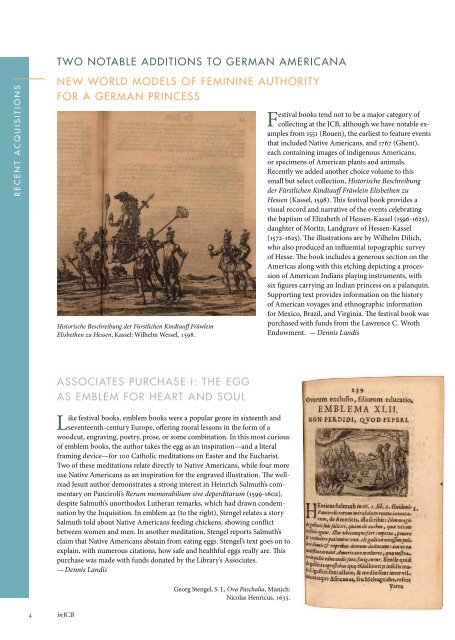You also want an ePaper? Increase the reach of your titles
YUMPU automatically turns print PDFs into web optimized ePapers that Google loves.
TWO NOTABLE ADDITIONS TO GERMAN AMERICANA<br />
recent acquisitions<br />
NEW WORLD MODELS OF FEMININE AUTHORITY<br />
FOR A GERMAN PRINCESS<br />
Historische Beschreibung der Fürstlichen Kindtauff Fräwlein<br />
Elisbethen zu Hessen, Kassel: Wilhelm Wessel, 1598.<br />
Festival books tend not to be a major category of<br />
collecting at the <strong>JCB</strong>, although we have notable examples<br />
from 1551 (Rouen), the earliest to feature events<br />
that included Native Americans, and 1767 (Ghent),<br />
each containing images of indigenous Americans,<br />
or specimens of American plants and animals.<br />
Recently we added another choice volume to this<br />
small but select collection, Historische Beschreibung<br />
der Fürstlichen Kindtauff Fräwlein Elisbethen zu<br />
Hessen (Kassel, 1598). This festival book provides a<br />
visual record and narrative of the events celebrating<br />
the baptism of Elizabeth of Hessen-Kassel (1596-1625),<br />
daughter of Moritz, Landgrave of Hessen-Kassel<br />
(1572-1625). The illustrations are by Wilhelm Dilich,<br />
who also produced an influential topographic survey<br />
of Hesse. The book includes a generous section on the<br />
Americas along with this etching depicting a procession<br />
of American <strong>In</strong>dians playing instruments, with<br />
six figures carrying an <strong>In</strong>dian princess on a palanquin.<br />
Supporting text provides information on the history<br />
of American voyages and ethnographic information<br />
for Mexico, Brazil, and Virginia. The festival book was<br />
purchased with funds from the Lawrence C. Wroth<br />
Endowment. — Dennis Landis<br />
ASSOCIATES PURCHASE I: THE EGG<br />
AS EMBLEM FOR HEART AND SOUL<br />
Like festival books, emblem books were a popular genre in sixteenth and<br />
seventeenth-century Europe, offering moral lessons in the form of a<br />
woodcut, engraving, poetry, prose, or some combination. <strong>In</strong> this most curious<br />
of emblem books, the author takes the egg as an inspiration—and a literal<br />
framing device—for 100 Catholic meditations on Easter and the Eucharist.<br />
Two of these meditations relate directly to Native Americans, while four more<br />
use Native Americans as an inspiration for the engraved illustration. The wellread<br />
Jesuit author demonstrates a strong interest in Heinrich Salmuth’s commentary<br />
on Panciroli’s Rerum memorabilium sive deperditarum (1599-1602),<br />
despite Salmuth’s unorthodox Lutheran remarks, which had drawn condemnation<br />
by the <strong>In</strong>quisition. <strong>In</strong> emblem 42 (to the right), Stengel relates a story<br />
Salmuth told about Native Americans feeding chickens, showing conflict<br />
between women and men. <strong>In</strong> another meditation, Stengel reports Salmuth’s<br />
claim that Native Americans abstain from eating eggs. Stengel’s text goes on to<br />
explain, with numerous citations, how safe and healthful eggs really are. This<br />
purchase was made with funds donated by the Library’s Associates.<br />
— Dennis Landis<br />
4 in<strong>JCB</strong><br />
Georg Stengel, S. J., Ova Paschalia, Munich:<br />
Nicolas Henricus, 1635.
















